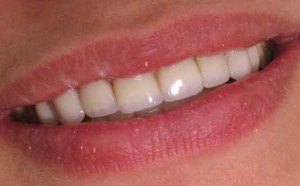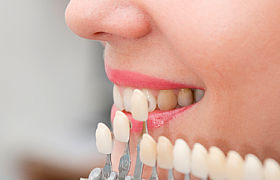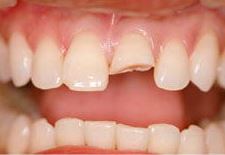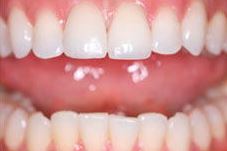Aesthetic restoration of teeth

Aesthetic restoration of teeth - The process of restoring the appearance and functionality of the dentition.
For restoration of teeth composite filling materials and veneers are used.
In the case when it is not only about tooth restoration, but also about achieving aesthetics of the dentition, they talk about aesthetic restoration.
Its synonyms are art and cosmetic restoration of teeth.
This dental procedure allows you to fix defects such as:
- Changing the shape and size of the tooth.
- Cracks, chipped teeth.
- Correction of tooth color, with the ineffectiveness of other methods.
Modern techniques
There are two methods of dental restoration: direct and indirect.
- Direct restoration of teeth is carried out by photopolymers or composite filling materials. The procedure is performed by a dentist.
- With indirect restoration, all tooth defects are repaired with veneers (plates), which are glued with special cement to the front surface of the tooth. Before installing the veneer, the front surface of the tooth is turned and a mold is taken, according to which the ceramic dental technician makes the structure.
Stages of aesthetic tooth restoration
The main stages of restoration are:

- Preparation for the procedure. It consists in hygienic cleaning of teeth from tartar and plaque, determining on a special scale the color of the tooth to be restored and the corresponding shade of the composite material.
- If necessary, local anesthesia is performed.
- Drilling old fillings and installing new ones if replacement of the old restoration is necessary.
- The tooth is isolated from the patient’s wet breathing and saliva. For isolation, a scarf with latex teeth openings is used. This measure is necessary because Moisture between the tooth and the restoration can lead to the formation of various problems, up to the appearance of caries and loss of structure.
- If the tooth crown is severely damaged (more than half), and the tooth is depulped, then the restoration should be strengthened with a pin.
- Restoration of the crown of the tooth with filling material. To make the tooth more natural, the technique of layer-by-layer application of filling material is used. Layers of restoration material of various transparency and shades are applied to each other, which will subsequently give the restored tooth a natural appearance.
- Finishing of the restored tooth. Final modeling is performed using burs, tooth shapes, followed by grinding and polishing of the restoration.
Video: “Restoration of the front teeth”
Features of restoration of aesthetics
Restoring aesthetics during restoration has the following key points.
Dental crown shape
The work to restore the shape of the tooth is reminiscent of the work of a sculptor who sculpts a model of a tooth using filling material instead of clay.
- It is very difficult to mold a tooth from the same plasticine with all the tubercles and fissures.
- To do this, you must have at least certain skills.
- Unfortunately, not every dentist is able to make a restoration indistinguishable from a real tooth.
Tooth color
It is important that the shade of the restored tooth matches the color of the remaining teeth.
- Filling materials used for tooth restoration have many shades.
- When layer-by-layer application of various shades on each other, it is possible to obtain various color combinations. Unfortunately, not all dentists can “play” with color.
- The problem is that the shade of the tooth from the cutting edge to the neck changes, and this point also needs to be taken into account. Otherwise, the restored tooth will be different from the rest.
Tooth transparency
Just as a tooth changes color from the cutting edge to the neck, its transparency changes.
Therefore, in the restoration of the tubercles and the cutting edge of the tooth, materials are used that will have greater transparency during curing.
disadvantages
The disadvantages of restorations are that they:
- Over time, restorations made of a composite can lose the gloss characteristic of a healthy tooth and darken. If this defect is not noticeable on the chewing group of teeth, then on the front teeth, it will immediately catch the eye of others. In this regard, such restorations must often be changed.
- If the tooth is damaged by more than half, and if it is also depulped, there is a risk of damage to the restoration. Most often, breakdowns occur with a high chewing load on the tooth, especially when it is restored from the root.
Indirect Restoration

- It is made using veneers.
- If the tooth, which is in the smile zone, is destroyed only on the front side, then installing the ceramic veneer will be the best way to restore it.
- Ceramic veneers do not lose their luster and do not darken.
Alternatives to restorations
- Crowns made of ceramics or cermets. If the tooth is badly damaged and also depulped, it is better to install a dental crown instead of restoration.
- To restore the posterior teeth, instead of restoring the filling material, you can use the tabs. In terms of service life and reliability, they surpass the restoration, and the ceramic insert will surpass the restoration aesthetically.
Cost
Prices for aesthetic restoration teeth are made up of several indicators:
- Clinical status and qualifications of specialists.
- The volume of restoration of the dental crown (full, partial, restoration of cleavage).
- Anesthesia depending on the drug.
- Cofferdam overlay.
- Pin fixation, depending on material and manufacturer.
- Consumables, including a sterile set (gloves, mask, boot covers, bib).
- The procedures for preparing the tooth for installing the veneer (tooth turning, casting, making veneer).
| Service | Price, rub.) |
| Restoration of chipped incisors | from 1600 |
| Restoration of ½ tooth | from 3500 |
| Complete crown restoration with fiberglass pin | from 5000 |
| Complete restoration of the tooth crown on a metal pin | from 4000 |
| Anesthesia | from 200 |
| The use of rubber dam | from 350 |
| Sterile set | from 100 |
| Composite Veneer | from 3000 |
| Ceramic veneer | from 12000 |
Reviews
Unfortunately, aesthetic restoration of teeth does not always receive positive reviews from patients.
The main reason for the negative attitude of patients is that not many doctors manage to do the job in such a way that the restored tooth is indistinguishable from the rest.
If, for example, when restoring a crown, its transparency is not taken into account, then such a tooth will look like a plastic crown.
- A few years ago she received a jaw injury, as a result the edge of the front tooth broke off. A year ago, she was treating her teeth, and the dentist suggested building a split tooth. They made restoration with a composite material, having previously selected the necessary shade. I was satisfied with the result. The tooth after restoration does not differ from the neighboring ones.
- I have had bad teeth since childhood. Constantly had to put seals. As a result, almost nothing remained of the front teeth on top. I didn’t want to install crowns, because I can’t afford crowns from ceramics. The dentist said that you can install the pins, and then build your teeth. I agreed. They installed two fiberglass pins for me, and new teeth were built on top of the light-curing composite. The teeth became like new.
- A few years ago, she treated the upper front tooth for tooth decay. At first, the seal, which was installed on the front surface of the tooth, was completely invisible, and then it darkened and became noticeable. She was embarrassed by others, when talking and smiling, she had to cover her mouth with her hand. Two years ago I turned to the dentist, and he advised me to install the veneer from the filling material. They restored my tooth so that it is like new. Six months ago, I began to notice that my little tooth was beginning to fade and change color. Probably have to redo everything soon.
Photo: before and after
 |
 |
 |
 |
 |
 |